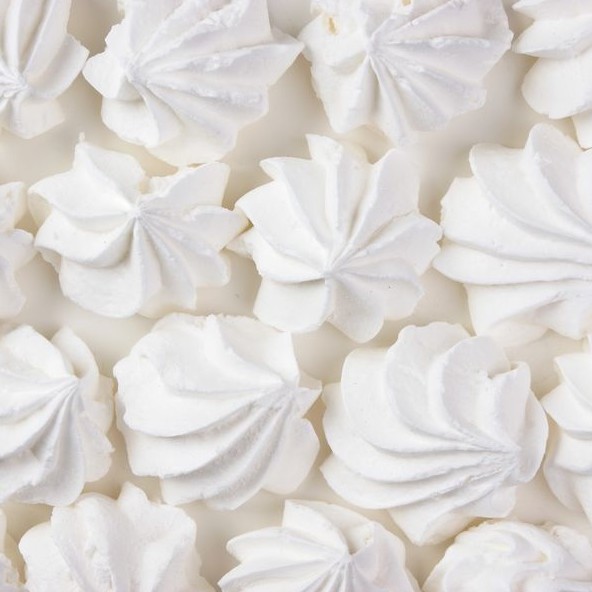
Meringue
What is Meringue?
A meringue is made by whipping egg whites with sugar into a stiff foam or frothy mixture. Usually, a small amount of acid is added to improve volume, stability and color. It can also be made with hot sugar syrup and other stabilizing agents, mainly hydrocolloids.
Meringue is a familiar topping for pastries and sweet goods. It can also be used as a main component which goes well with the composition of batters or foams. A few products with meringue are:
- Cream or chiffon pie
- Sponge, foam, or chocolate velvet cake
- Parisian macarons
- Italian (boiled) meringue
- Marshmallow
Origin
The first recipe for meringue was referred to as white biscuit bread and appeared in cookbooks in 1604. It is rumored to have been invented in or near the town of Meiringen Switzerland, although this has been disputed. The word meringue first appeared in a French cook book in 1692. In Italy the recipes continued to change and adapt. Today, meringue is remarkably similar to the product made in the 1700s.
Meringue Formulation and Process
| Ingredient | Baker’s % (based on flour weight) |
| Liquid egg whites* | 100.0 |
| Cream of tartar | 1.0–3.0 |
| Sugar (refined, granulated)** | 60.0 |
*Can be frozen, pasteurized/refrigerated (liquid) or dried.
**Superfine granulated sugar can alos be used. This type of sugar contains crystals that are intermediate in size between powdered sugar and regular granulated sugar. Superfine sugar dissolves more quickly in liquids than regular granulated sugar, thus allowing the incorporation of smaller air cells into the foam.
Preparation of meringue
Two methods are commonly used:
- Cold meringue method: the egg whites are beaten until stiff, then sugar is gradually added. The mixture is whipped until desired consistency.
- Hot meringue method: water is boiled and a slurry of starch is added. Sugar is incorporated into the boiling mixture until it thickens. When the whipped egg white reach a medium peak, the hot syrup is gradually added. This method is beneficial in preventing weeping of the meringue mass. Other thickeners may be used in place of starch.
A variety of meringue bases and egg-free alternatives are also available for bakers.
Variations
There are many variations of this dessert. The most common additions are vanilla, coconut, and almond extract. Fruit is sometimes added to give unique flavors. French meringue is the most common recipe made at home and is simply egg whites, sugar, and cream of tartar mixed together. During baking at 392°F (200°C) the egg protein denatures completely, loses its elasticity and sets to a firm structure.
Italian (boiled) meringue is stiffer and more stable than French meringue. It’s made by boiling sugar-water mix to a hard ball stage of 250°F (121°C). Then, it’s poured over well-beaten egg whites. This cooks the egg whites as it is made, allowing consumption of this meringue without baking.
Application
In preparing meringues and similar whipped goods, there is a stage at which the mixture will form a persistent point when the beater is pulled vertically from the beaten mixture. When short and stiff, it is called a dry peak. When the peak is long, soft, and tends to bend over, it is called a wet peak.
During mixing or whipping, air is incorporated and entrapped by the egg foam. This causes the product to become light and porous. Specific gravity is often used as an indicator to determine proper mixing of the foam. The longer the whipping, the lower the specific gravity, the firmer and the drier the foam will be.
General recommendations when using egg products
- Frozen egg products should be thawed under refrigeration for up to 48 hours, then stirred before using.
- Dried egg whites need to be reconstituted in water before use according to the manufacturer’s instructions. When using alternative forms for egg whites, follow supplier instructions if reconstitution with water, supplementation and liquid/solids balancing are needed.
- Dried egg products must be stored under refrigeration.
- Pasteurized eggs are recommended when the preparation requiring eggs will not be cooked, such as for an unbaked meringue pie topping.
- When determining liquids in formula balance, It is important to remember that egg whites are 12% solid (sugar and protein) and 88% liquid.1
References
- Figoni, P. “Eggs and Egg Products.” How Baking Works, 3rd edition, John Wiley & Sons, Ltd, 2011, pp. 258–297.

